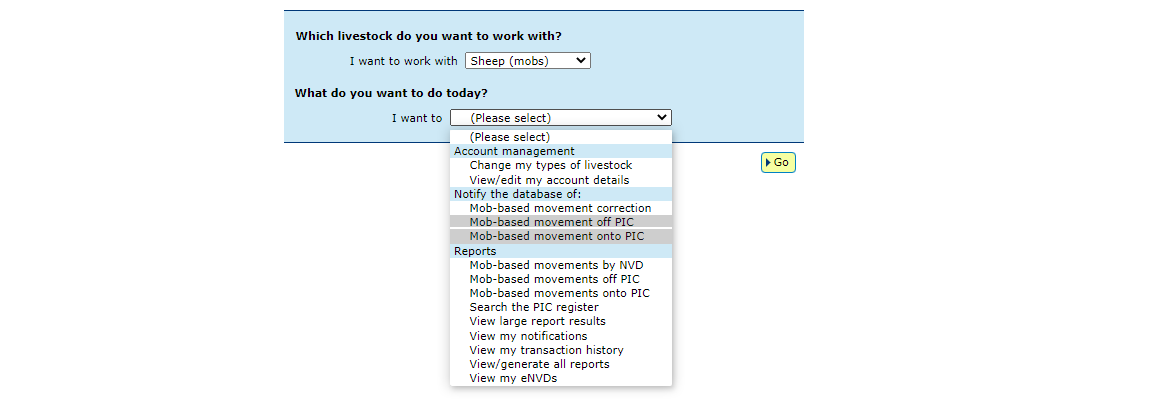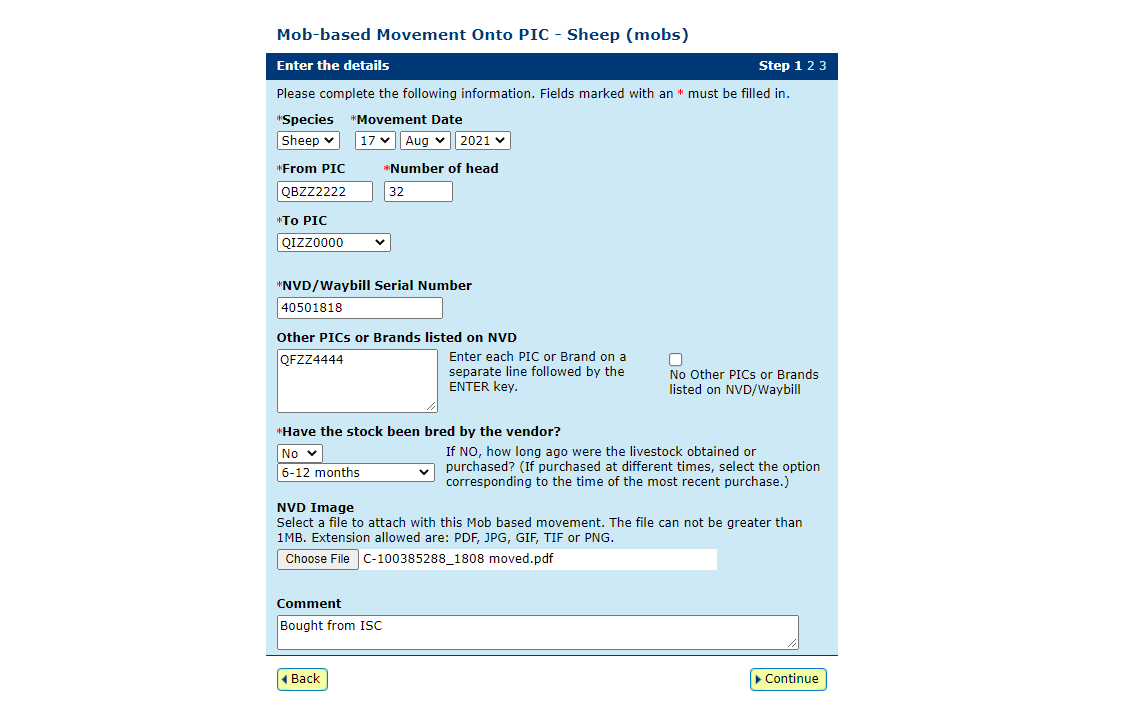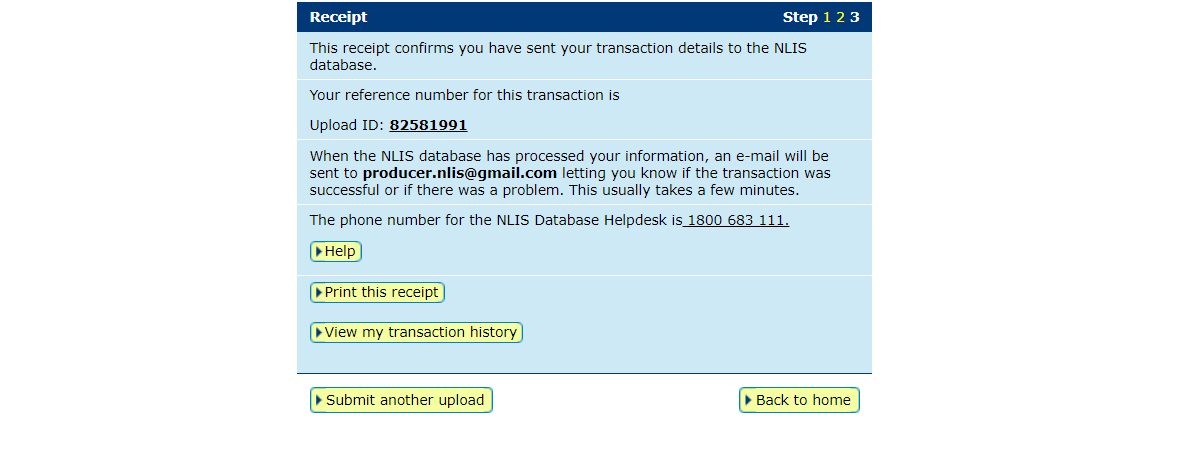NLIS how-to guides
Need help or guidance accessing the NLIS database? Our series of NLIS how-to guides are here to help. Simply answer the questions in the drop down boxes below.
Please note: The NLIS database will be unavailable between 6.00pm and 8.00pm (AEDT) every second Thursday, for routine maintenance. View the NLIS maintenance dates.
If you need further help please contact ISC Customer Service on 1800 683 111 (Monday - Friday between 8am-7pm AEST) (Saturday - Sunday between 9am - 5pm AEST) or email info@integritysystems.com.au.
How-to: Move a mob onto / off a PIC – type in details
Following a physical movement of livestock, completing a mob-based transfer in the NLIS database ensures that the database can trace animals to their property of birth and last property of residence.
This is a legislative requirement in each state and territory. Each jurisdiction is responsible for enforcing the regulatory requirements for NLIS, specifying how and when livestock transfers within the NLIS database must be completed.
This how-to demonstrates the process to transfer mob-based livestock onto or off a PIC by typing in the details after a physical movement of stock has occurred.
What is a mob?
A mob can be one or more sheep or goats that only have a visual tag. As these individual livestock cannot be identified with a RFID device or NLIS ID tag, they must be moved through the mob-based movement methods.
If you have sheep or goats with RFID device or NLIS ID tag, then the NLIS database must be notified of the individual device or tag numbers to maintain lifetime traceability.
What is a movement?
Completing a movement on the NLIS database means transferring stock from one PIC to another PIC to reflect the physical location of the animals.
Who updates the NLIS database?
The person responsible for updating the NLIS database varies depending on the situation:
- If livestock are bought, sold or moved through a saleyard, the livestock movement must be recorded by the saleyard.
- For sales or movements that do not take place via a saleyard, the buyer/receiver of the livestock must record the livestock movement.
- The vendor/sender of the livestock is not obligated to record the movement off their property, although they may do so. ISC recommends checking that the movement has occurred to ensure your NLIS records are up-to-date. This includes livestock being sent to abattoirs or saleyards. Run the ‘Mob-based movements onto PIC’ report.
- Abattoirs must record movements for all livestock they receive.
When do producers need to update the NLIS database?
A mob-based movement needs to be recorded on the NLIS database by a producer when:
- You have purchased animals privately and need to complete the transfer as the receiver of the livestock.
- You own more than one property with different PIC numbers and need to transfer livestock between your own PICs.
- You have sold livestock privately and you want to complete the transfer because the receiver is unable to do so.
Before you start
- Locate details of the PICs you are transferring between, other PICs on the visual tag, the date the stock movement occurred, the NVD number and eNVD pdf or NVD/Waybill image.
Alternatively, you may like to use the How-to: Move mobs onto/off a PIC - file upload method.
- Log in to the database at nlis.com.au with your username and password.
*QUICK TIP: A myMLA account can provide access to your NLIS and LPA accounts with just one username and password. Link your accounts today.
How-to: In brief
1
Select mob-based species and ‘Mob-based movement off PIC’ or ‘Mob-based movement onto PIC’ action. > Go
2
Select ‘Type in details’ and then enter details in the compulsory fields. > Continue
3
Confirm all details and then submit. > Continue
How-to: Step-by-step
Step 1
Once logged in, select the mob-based species you are working with. Under the Nnotify the database of:’ section select the action ‘Mob-based movement off my property’ or ‘Mob-based movement onto my property’. Click ‘Go’.

Step 2
Click ‘type in the details’ and then enter details in the compulsory fields (marked with a red star). Click ‘Continue’.

*QUICK TIP:
- If the mob includes stock that have not been bred by the vendor, you must enter the other PICs printed on the tags into the ‘Other PICs or Brands listed on NVD’ box.
- If you want to attach a copy of the eNVD or NVD/Waybill form related to this mob, click 'Browse' and select the file from your computer. Do not include special characters e.g. ‘&’ in the name of your file. When completing an eNVD, download the document to a pdf manually or take a photo of your hardcopy NVD/Waybill to upload.
- You can enter a comment of up to 255 characters about this movement, but do not include special characters such as full stops or commas.
Step 3
Confirm the details you have entered are correct. If you notice an error, click ‘Back’ to update those fields. With the data correct, click ‘Continue’ to submit the information to the database.

Step 4
The database will provide a receipt on-screen. It’s recommended to record the 'Upload ID' or to 'Print this receipt' for reference.
*QUICK TIP: To ensure the transfer was received by database, click ‘View my transaction history’ to check the status of your ‘Upload ID’ is marked as Complete. If another status is shown, you will need to read the generated email for specific details about the outcome. These other status notes may be:
- Warning: the transfer is complete but a tag or tags were marked with a message that you will need to investigate / review.
- Error: one or more tags were not able to be moved and need your review or investigation.
- Failure: technical issues occurred with the database and the movement was not completed.
- Bad Format: there were errors in the preparation of the .csv file. Review and or contact ISC Customer Service on 1800 683 111.

*QUICK TIP: Record the 'Upload ID' provided after each transfer. If details are incorrectly submitted, you will need to immediately conduct a Transfer correction action. This action only amends details of the previous transfer and will request the 'Upload ID' of that transfer. If you notice an error in earlier transfers and need to correct it, contact ISC Customer Service on 1800 683 111.